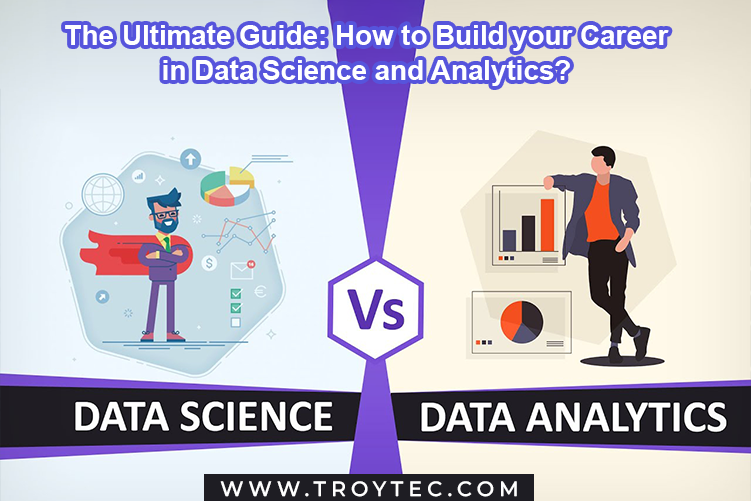The ideal Guide: How to Build your Career in Data Science and Analytics?
What is data science?
Data science is the area of applying sophisticated analytical methods and scientific principles to extract practical information from data for business decision-making, strategic planning, and other uses. It is becoming highly essential to the industry. The insights generated by data science assists associations increase operational efficiency, recognizing fresh business opportunities, and enhancing marketing and sales programs. Ultimately, they can lead to a competitive edge over business rivals.
It is a research area that uses state-of-the-art tools and techniques to process vast amounts of data, find hidden patterns, derive meaningful data, and make business decisions. It utilizes intricate machine learning algorithms to create predictive models. The data used for analysis can be acquired from diverse sources and displayed in various formats. The data science life cycle consists of five stages, each with its tasks.
Capture: It includes data acquisition, signal reception, data entry, and extraction. At this stage, the collecting raw structured and unstructured data is collected.
Maintenance: It includes data warehousing, staging, processing, cleansing, and data architecture. You must get the raw data and put it in a functional format at this stage.
Processes: It includes data mining, categorization, data modeling, and summarization. Data scientists take the prepared data and examine its patterns, ranges, and biases to determine its usefulness in predictive analytics.
Analysis: Exploratory/confirmatory, predictive, regression, text mining, qualitative research. The investigation is the backbone of the life cycle. At this stage, you perform various analyzes of the data.
Communication: It includes data reporting, visualization, business intelligence, and decision making. In this final step, the analyst prepares the analysis in an easy-to-read format like graphs and reports.
Roles of data sciences
Before you jump the gun and choose a qualification or course to take, it is good to understand that the data science industry, not just data scientists, has a variety of roles.

Data Scientist: Keep the most obvious out of the way to avoid confusion. Data scientists extract, analyze, and interpret large amounts of data from various sources. They understand the needs of the business, use the data to make hypotheses, analyze the data, and explore different patterns in the business plan. We also use algorithmic approaches, artificial intelligence, machine learning, and statistical tools to analyze the data further and help our business. Business analytics is also implemented in the role of a data scientist, showing companies how data will impact or benefit them in the future.
Business Intelligence Analyst: The role of a business intelligence analyst is to identify potential improvements, identify trends, and leverage data to help your business grow. They can remember potential problems and offer solutions, allowing companies to understand their position better.
Data mining engineer: Data mining is extracting, organizing, and recognizing patterns in extensive datasets that can enhance your business’s systems and processes. Data mining engineers set up and manage the infrastructure for storing and analyzing data. Their roles include building a data warehouse and organizing data to make it accessible to other team members. The main acronym for a data mining engineer task is ETL. Extract, convert, and read.
Data architect: Data architects create blueprints that data management systems use to centralize, integrate, manage, maintain, and protect internal and external data sources. Data architects work closely with users, developers, and system designers to give employees access to certain important information where they are assigned.
Core for data science
Big data: All data is large or complex datasets that traditional data processing software cannot manage. Therefore, data scientists need to know Apache Hadoop or Apache Spark, open-source distributed processing systems.
Data Modeling: Data modeling is formatting specific data into a database.
Data Visualization: A graphic representation of the data displays trends and insights.
Machine learning: Machine learning is a set of techniques to predict data.
Programming: When automating data manipulation, it is essential to know a programming language such as Python or R.
Statistics: You do not have to be a statistician, but to interpret the data, you need to know the statistics that apply in some way.
What is data analytics?
Data analysis is an area focused on extracting insights from data. It consists of data analysis and management processes, tools, and techniques, including data collection, organization, and storage. The primary purpose of data analysis is to apply statistical analysis and technology to the data to find trends and solve problems. Data analysis is becoming increasingly crucial in enterprises to analyze and shape business processes and improve decision-making and business outcomes.
Data analysis is leveraged from a variety of disciplines such as computer programming, mathematics, and statistics to perform data analysis to describe, predict, and improve performance. Teams leverage data management techniques to ensure robust analysis, including data mining, cleansing, transformation, and modeling.
Types of data analytics
Data analysis is a wide range of fields. There are four main types of data analysis; each type has different goals and locations for the data analysis process.

Descriptive analysis: These procedures summarize extensive datasets and define the results to stakeholders. These strategies track success or failure by forming key performance indicators (KPIs). Indicators like ROI (return on investment) are utilized in many industries. Detailed metrics have been designed to track the performance of a specific sector. This procedure demands gathering relevant data, processing the data, interpreting the data, and visualizing the data. This process provides critical insights into the past interpretation.
Diagnostic analysis: These techniques complement the more fundamental descriptive analysis. They take findings from descriptive analysis and go more in-depth to find the cause. KPIs are further analyzed to determine the reason behind their performance. This usually happens in three steps; Firstly, data anomalies are identified. These can be metrics or unexpected changes in a particular market. Then data related to these anomalies will be compiled. Lastly, statistical techniques are used to see relationships and trends that define these anomalies.
Predictive analytics: These techniques employ historical data to determine trends and if they are likely to recur. Predictive analytics tools provide practical insights into what will happen in the future, including different statistical and machine learning approaches like neural networks and regression.
Prescriptive analytics: You can make data-driven decisions employing predictive analytics insights. It allows corporations to make educated decisions in the face of uncertainty. Their techniques depend on machine learning techniques to discover patterns in enormous datasets. You can assess the potential for various outcomes by analyzing past choices and events.
Core skills for analytics
A / B testing: Simply, it is a statistical approach that compares two variable versions in a controlled environment. It is used to specify which variable version is functioning better than the others.
Programming: A data analyst must have brilliant programming skills in languages like Python and R.
Domain knowledge: It can be considered a specialty, like you know the industry, if you have a lot of work background and necessary expertise, especially in the retail sector.
Excel: Microsoft Excel is often used to handle small datasets.
Data Visualization: Like data scientists, analysts must know how to use data to tell their stories to interested groups using data visualization tools like Tableau.
SQL is a database language utilized for data administration and construction of database structures. SQL is often used as an option for Excel because it is appropriate for processing extensive datasets.
Reporting: As a data analyst, you also need proper communication and presentation skills.
Data analysis vs. data science
Data analysis and data science are inextricably linked. Data analysis is a component of data science and is used to understand what your organization’s data looks resemble. In general, the output of data analysis is reports and visualizations. Data science uses the production of analysis to study and solve problems. The difference between data analysis and data science is often considered one of the timescales. Data analysis describes the current or past state of reality, and data science uses that data to predict or understand the future.
Ask yourself about the right data science career for you.
Determining if a data science career is right for you is not just about asking if you like working with data. It is about asking yourself if you want to tackle challenging and ambiguous situations and whether you have the talent and tolerance to build a skill set. To determine if your data science career is right for you, you should be able to answer a few things. You need to know if you are devoted to learning technical subjects and whether you are willing to learn other kinds of advanced mathematics.
You should enjoy storytelling with data, enjoy computer science and programming, and try to create a new project on your own independently.
Are you a data analyst?
Data analysts are generalists. Its means you can work in different teams and roles. They enjoy working on well-defined structured issues. Use the data to extract and generate valuable reports for your business. Successful data analysts enjoy some complexity, but not as much as data scientists.
Are you a data scientist?
Data scientists love the complexity and enjoy answering various random questions. They are eager to grow and provide insights on project-based challenges. They are less likely to work on diverse assignments than data analysts.
Data scientists love the complexity and enjoy answering various random questions. They are excited to grow and provide insight on project-based challenges. They are less likely to work on different assignments than data analysts.
So you may be suitable for your career as a data scientist if you enjoy the complexity and ambiguity.
Are you a data engineer?
Data engineers are very technical. They organize and structure raw data so data scientists and analysts can perform their tasks. Sound data engineers enjoy building data pipelines and like software development. They highly understand programming languages such as Java, SQL, and SAS.
Tips to start your career in this field
Here are five tips to consider to start your career in data science and make your application stand out.
Soft and industrial skills: They are expected to crack complex real-life situations based on data trends and patterns, so they must combine soft skills and thorough profile or work-related skills. You must be good at comprehending the basics of data science, programming learning, predictive modeling, statistical skills, data analysis, manipulation, and data visualization. Other than that, essential machine learning, big data, deep learning, and software engineering knowledge are also crucial. Teamwork, time management, collaboration, communication, structured thinking, problem-solving, and leadership skills are additional skills to justify running for a new job in data science.
Build a professional portfolio: Incomplete, casual, or unorganized portfolios can hinder your hiring chances. Your portfolio contains many elements other than resumes and cover letters, each of which needs to guarantee your candidate. Build a professional digital portfolio that you can easily share with recruiters.
Learn from Experts: To help yourself choose a beginner-level course or discipline. Suppose you are an undergraduate, are not confident in your interests, and are still exploring. In this case, you can sign up for short-term, affordable data science training for beginners to admit the confusion. You will also get industry-recognized certificates, placement assistance, and insightful sessions with industry experts to validate your domain’s professional skills.
Get practical exposure through internships: Internships will help you develop and improve your data science skills after learning and practicing data science beginner-level concepts. You can apply your theoretical knowledge, gain confidence, gain the feeling of working in the industry, improve your practical skills and motivate yourself.
As an aspiring data scientist, you must stay up-to-date on industry trends, technological advances, changes in customer behavior, best practices, and global activity in your area. Stay connected to the programming and data science community, watch tutorials, get inspiration from professional work, read and share relevant articles, and provide valuable feedback, webinars, and conferences by tech leaders.


